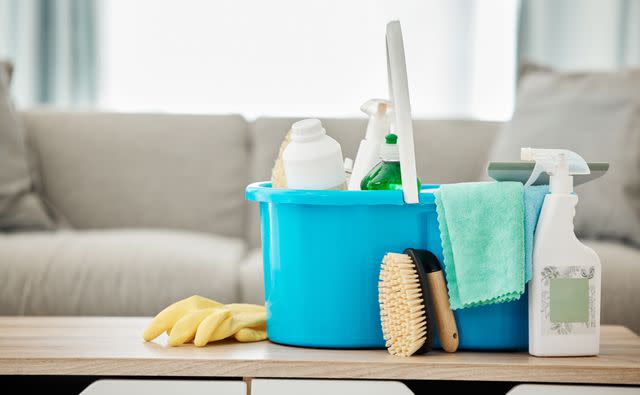Common Cleaning Products That Are Dangerous to Combine
Combining these cleaning products can create potentially harmful chemical reactions.
When it comes to cleaning your home, you want to ensure you're getting the deepest clean possible—especially in high-touch areas like the kitchen and bathroom. Sometimes, this means combining multiple products to thoroughly scrub away built-up dirt and grime. But it's essential to exercise great caution when mixing cleaning products, as certain combinations—like bleach and vinegar—can create toxic fumes and gases that pose serious health concerns when inhaled. To keep you safe while you clean, we're sharing several common products you should never combine.
Meet the Expert
Maryann Amirshahi, PharmD, MD, MPH, PhD, FACMT, FACEP, FASAM, FCP, co-medical director of the National Capital Poison Center
Alicia Sokolowski, president and co-CEO of AspenClean
Kathy Cohoon, director of franchise operations of Two Maids
Related: 8 Items You Should Never Put in the Dishwasher

PeopleImages/Getty Images
Bleach and Vinegar
On their own, bleach and vinegar are two effective household cleaning supplies, but they should never be used in tandem. "Mixing these two cleaning products results in the formation of chlorine gas," says Maryann Amirshahi, PharmD, MD, MPH, PhD, FACMT, FACEP, FASAM, FCP, co-medical director of the National Capital Poison Center. "Chlorine gas is very irritating to the airways and eyes. It can cause serious breathing problems. When chlorine gas reacts with water, it can form an acid that causes skin burns."
Hydrogen Peroxide and Vinegar
Combining hydrogen peroxide and vinegar can create a potentially dangerous chemical reaction. "The mixture can produce peracetic acid, a corrosive substance that can irritate the eyes, skin, and respiratory system," says Alicia Sokolowski, the president and co-CEO of AspenClean. "Peracetic acid is also potentially harmful if ingested." Combining these two cleaning supplies can also release vapors that can be dangerous to inhale.
Bleach and Ammonia
It is extremely dangerous to mix bleach and ammonia. "Combining these two chemicals produces chloramine, another toxic gas that irritates the eyes and airway, making it hard to breathe. In higher concentrations, it can cause nausea, and vomiting, and damage lung tissue," says Amirshahi.
Bleach and Rubbing Alcohol
Combining bleach and rubbing alcohol is dangerous to both your health and the surfaces you're cleaning. "Due to acidic properties, mixing rubbing alcohol and bleach creates chloroform and is highly toxic," says Kathy Cohoon, the director of franchise operations of Two Maids. "It can cause major organ damage as well as act as a corrosive agent and break down surfaces it touches."
Different Drain Cleaners
Combining different drain cleaners can be dangerous because they're not equally formulated, meaning each one contains a different chemical makeup. "Most drain cleaners contain pretty strong chemicals to begin with, and mixing them can make matters worse," says Amirshahi. "Some products contain strong acids, while others contain strong bases. Mixing acids and bases can cause a chemical reaction that generates heat, which can cause thermal burns. It may also release toxic gases depending on the product involved."
Related: 4 DIY Drain Cleaner Recipes That Use Natural Ingredients to Prevent Clogs
Mildew Stain Remover and Bleach
Most mildew stain removers contain ammonia or other acids to help break down mildew and lift stains. "Those ingredients mixed with bleach can cause gas fumes and are potentially poisonous," says Cohoon. Combining these supplies can cause respiratory distress, irritation of the eyes, nose, and throat, and is particularly harmful in enclosed spaces, says Sokolowski.
Oven Cleaner and Bleach
Oven cleaners often contain alkaline substances, and mixing them with bleach can produce chlorine gas. "Like other combinations, it can cause respiratory distress, irritation of the eyes, nose, and throat, coughing, and chest pain," says Sokolowski. "Like bleach and ammonia, it can also lead to some burns."
Toilet Bowl Cleaner and Bleach
Mixing toilet bowl cleaner and bleach is another combination that can produce chlorine gas. "Also, mixing toilet bowl cleaner with bleach can neutralize the active ingredients in both products, reducing their cleaning effectiveness," says Sokolowski.
Glass Cleaner and Bleach
Glass cleaners often contain ammonia, meaning mixing them with bleach can release chloramine gas, says Amirshahi. This toxic gas can irritate the eyes and airway, making it difficult to breathe and may even cause nausea and vomiting.
Read the original article on Martha Stewart.

